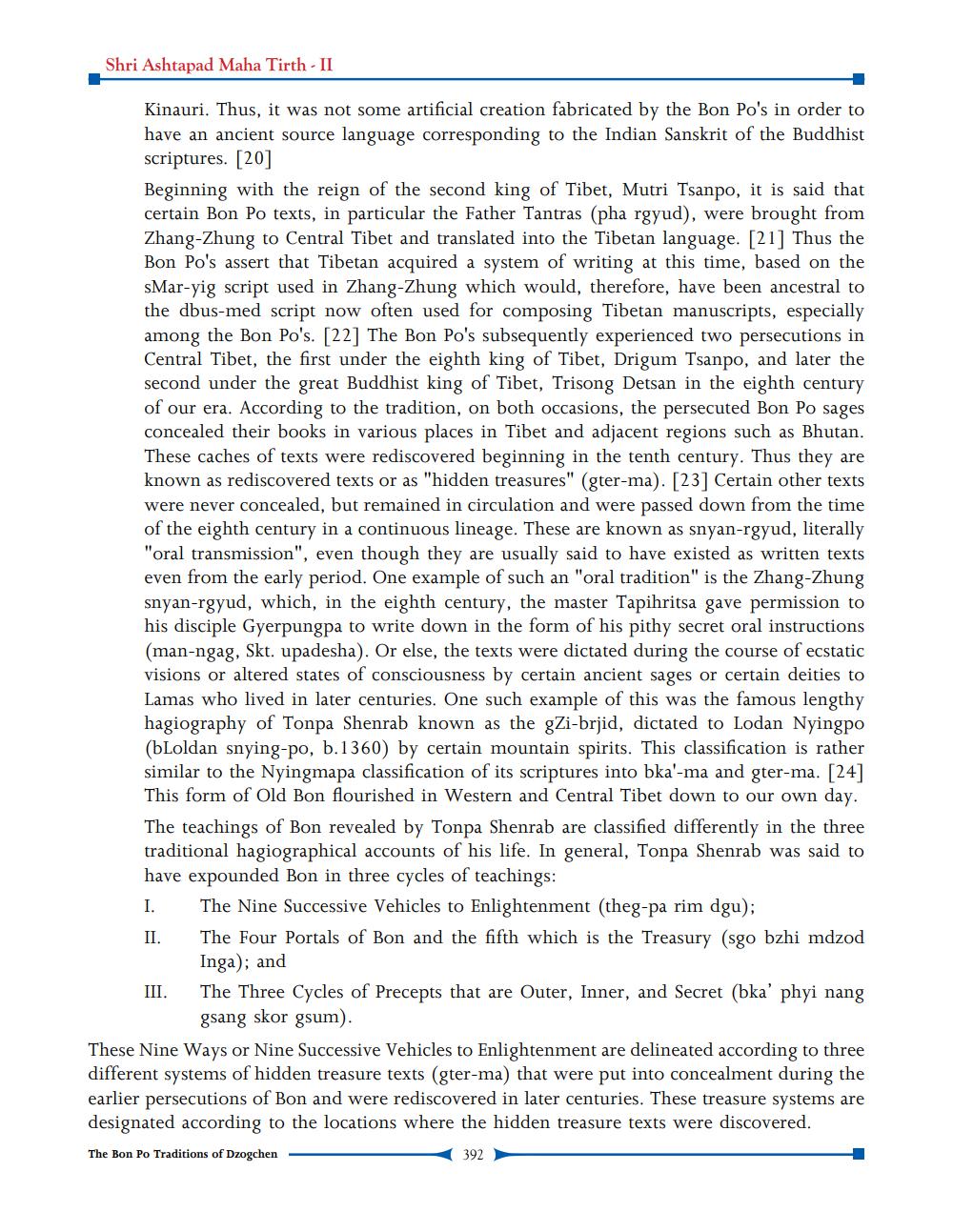________________
Shri Ashtapad Maha Tirth - II
Kinauri. Thus, it was not some artificial creation fabricated by the Bon Po's in order to have an ancient source language corresponding to the Indian Sanskrit of the Buddhist scriptures. [20] Beginning with the reign of the second king of Tibet, Mutri Tsanpo, it is said that certain Bon Po texts, in particular the Father Tantras (pha rgyud), were brought from Zhang-Zhung to Central Tibet and translated into the Tibetan language. [21] Thus the Bon Po's assert that Tibetan acquired a system of writing at this time, based on the sMar-yig script used in Zhang-Zhung which would, therefore, have been ancestral to the dbus-med script now often used for composing Tibetan manuscripts, especially among the Bon Po's. [22] The Bon Po's subsequently experienced two persecutions in Central Tibet, the first under the eighth king of Tibet, Drigum Tsanpo, and later the second under the great Buddhist king of Tibet, Trisong Detsan in the eighth century of our era. According to the tradition, on both occasions, the persecuted Bon Po sages concealed their books in various places in Tibet and adjacent regions such as Bhutan. These caches of texts were rediscovered beginning in the tenth century. Thus they are known as rediscovered texts or as "hidden treasures" (gter-ma). [23] Certain other texts were never concealed, but remained in circulation and were passed down from the time of the eighth century in a continuous lineage. These are known as snyan-rgyud, literally "oral transmission", even though they are usually said to have existed as written texts even from the early period. One example of such an "oral tradition" is the Zhang-Zhung snyan-rgyud, which, in the eighth century, the master Tapihritsa gave permission to his disciple Gyerpungpa to write down in the form of his pithy secret oral instructions (man-ngag, Skt. upadesha). Or else, the texts were dictated during the course of ecstatic visions or altered states of consciousness by certain ancient sages or certain deities to Lamas who lived in later centuries. One such example of this was the famous lengthy hagiography of Tonpa Shenrab known as the gZi-brjid, dictated to Lodan Nyingpo (bLoldan snying-po, b.1360) by certain mountain spirits. This classification is rather similar to the Nyingmapa classification of its scriptures into bka-ma and gter-ma. [24] This form of Old Bon flourished in Western and Central Tibet down to our own day. The teachings of Bon revealed by Tonpa Shenrab are classified differently in the three traditional hagiographical accounts of his life. In general, Tonpa Shenrab was said to have expounded Bon in three cycles of teachings: I. The Nine Successive Vehicles to Enlightenment (theg-pa rim dgu);
The Four Portals of Bon and the fifth which is the Treasury (sgo bzhi mdzod Inga); and The Three Cycles of Precepts that are Outer, Inner, and Secret (bka' phyi nang
gsang skor gsum). These Nine Ways or Nine Successive Vehicles to Enlightenment are delineated according to three different systems of hidden treasure texts (gter-ma) that were put into concealment during the earlier persecutions of Bon and were rediscovered in later centuries. These treasure systems are designated according to the locations where the hidden treasure texts were discovered. The Bon Po Traditions of Dzogchen
392




